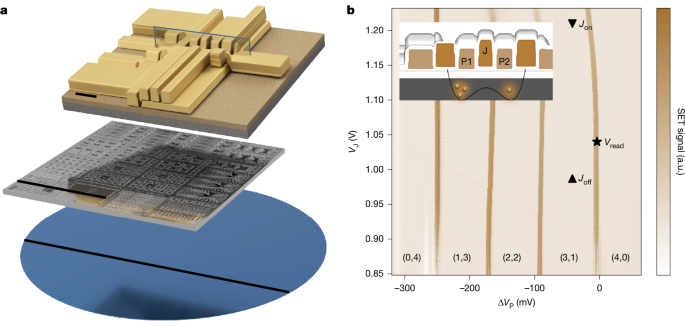
"However, recent attempts to fabricate spins-in-silicon quantum dots using industrial-scale fabrication has raised awareness about the material challenges that must be faced. For example, it is crucial to reduce the charge noise and static disorder arising due to defects and traps at interfaces and oxides18,19,20. High-fidelity single-qubit operations can be performed with minimal impact from charge noise because the electron spin couples to the noisy electric fields only through its weak spin-orbit effects21,22,23,24,25."
"This sensitivity has motivated the search for ways of mitigating the effects of charge noise, including moving spin states away from the interface to quantum wells26,27. However, from a scaling perspective, it is desirable to reconcile as much as possible conventional complementary metal-oxide-semiconductor (CMOS) processes with qubit fabrication to leverage the mature CMOS industry to the fullest extent. Moreover,"
"The early academic successes of silicon spin-qubit technology1,2,3,4,5,6,7,8 created enthusiasm for the idea that these qubits could be fabricated in industrial 300-mm manufacturing lines9,10,11,12. Potential advantages include the ability to leverage advanced fabrication processes, to integrate qubits with modern electronics and to benefit from the existing capabilities of mass manufacturing at low costs12. Over the past decade, there have been a number of proposals for potential architectures that could be used to realize a scalable quantum computer based on silicon spin qubits13,14,15,16,17."
Early experiments demonstrated silicon spin-qubit viability and suggested fabrication in industrial 300-mm CMOS lines could leverage advanced processes, integration with electronics, and low-cost mass manufacturing. Industrial-scale fabrication exposes material challenges, particularly charge noise and static disorder from defects and traps at interfaces and oxides. Single-qubit gates achieve high fidelity because electron spins couple weakly to electric-field noise through spin-orbit interactions. Initialization, read-out, and exchange-based two-qubit gates are more sensitive to charge noise in conventional MOS gate stacks. Mitigation strategies include moving spin states into quantum wells, while retaining CMOS compatibility offers benefits such as large valley splitting and efficient electrostatic coupling for thin-oxide quantum dots.
Read at Nature
Unable to calculate read time
Collection
[
|
...
]